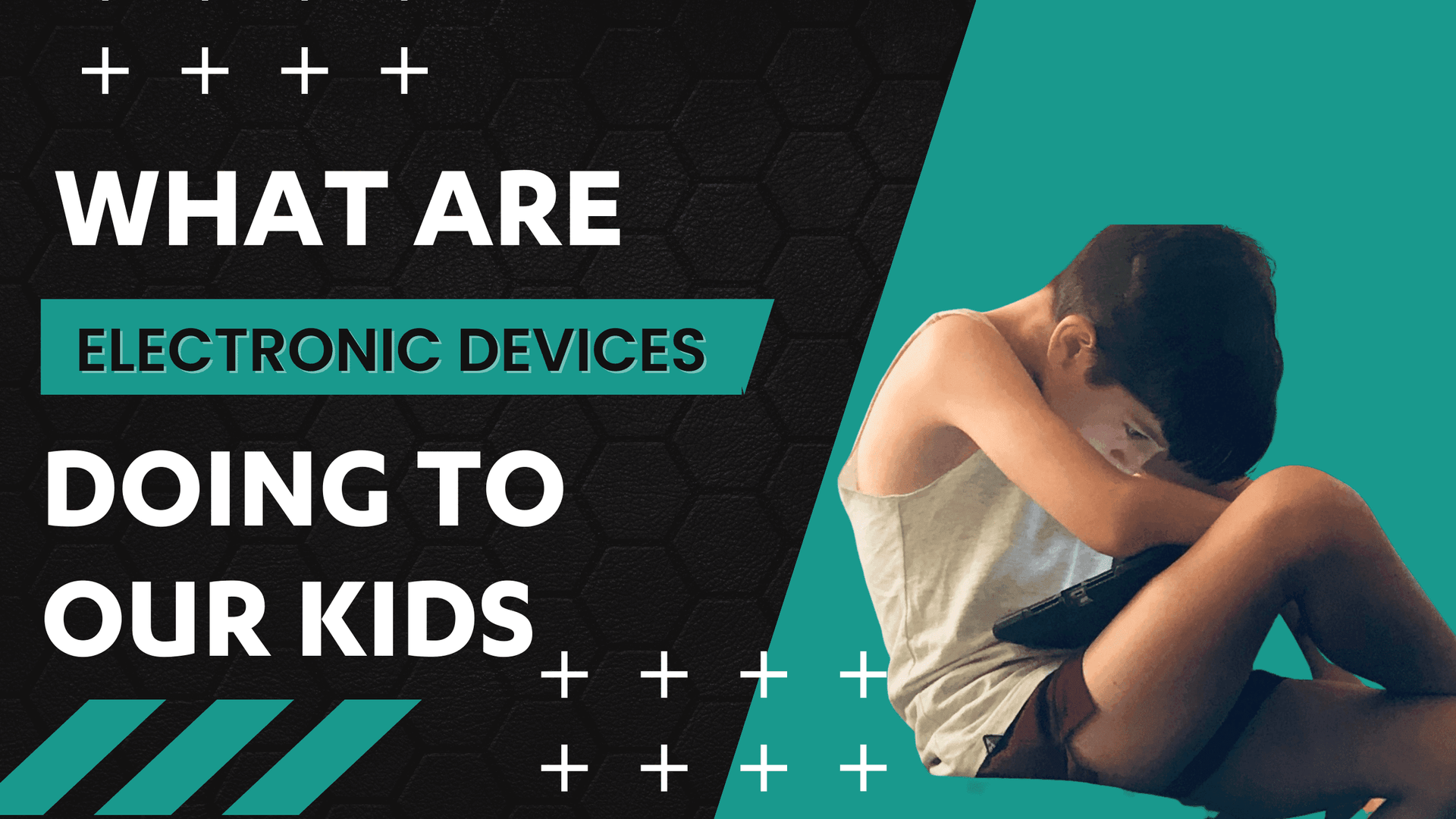
What are electronic devices doing to our kids?
Oh, kids and their gadgets! They can't seem to get enough of them. Phones, iPads, laptops, gaming consoles, you name it. Technology has become such an integral part of their lives that it's hard to imagine what they would do without them. But, as much as we love the convenience and entertainment that technology offers, there's a dark side that we mustn't ignore.
Let’s delve a little deeper into how prolonged exposure to electronic devices may be hurting your child’s development.
Tunnel Vision
Spending time staring at a screen can result in acute foveal (or tunnel) vision. Sadly, with this comes a reduction in acuity of peripheral vision. This can be especially dangerous when these kids grow up to drive cars, as good peripheral vision is required to be able to notice other cars coming from different directions to give the opportunity for faster reaction times. Let alone the fact that they have shorter attention spans, and may find it difficult to remain vigilant and be unable to concentrate on long drives.
Attention Spans
Kids these days have shorter attention spans than ever before. The reason? Technology. The research supports this concern. Jim Taylor, Ph.D., wrote in Psychology Today that heightened technology exposure might actually be changing the way children’s brains are wired. With all the distractions that technology provides, it's no wonder that kids find it hard to focus on anything for more than a few minutes. According to a study by Microsoft, the average attention span of a human has decreased from 12 seconds in 2000 to just 8 seconds in 2013. That's one second less than a goldfish! So, if you're wondering why your child can't seem to focus on their homework for more than a few minutes, you can thank technology for that.
Developing Brain
And what about the impact on the rapidly developing brain? Kids who spend too much time on devices are at risk of developing what is known as the "internet approach to thinking." This means that they are quickly scanning and processing multiple sources of information all at once, but not delving into any one of them deeply. Developing brains are particularly vulnerable to this, and whilst previous generations spent more time reading, imagining, or participating in activities that require problem solving, brains in children exposed to high volumes of technology may adapt to frequent visual stimulation, rapid change, and little need for imagination. This can lead to a lack of critical thinking skills and an inability to absorb information properly.

School performance
Let's not forget about the impact on school performance either. Kids who spend too much time on devices are unlikely to perform as well in school compared to their peers who don't. Limited attention spans, as mentioned previously, can also contribute to how children perform in the classroom. One experienced English teacher told the New York Times that students “lack the attention span to read assignments on their own,” due to mobile phones and social media. As well as the effects being on electronic devices has on their attention span, their developing brain and their concentration, school performance is also impacted by kids being distracted by their devices during class directly.
Aggression
What the kids are watching on these electronic devices need to be taken into account too. Exposure to violent games has lead to an increased tendency towards aggression and lack of empathy in real life. It’s like they’ve been desensitised. Kids who spend too much time playing violent games are less likely to feel the impact of actual violence, leading to a lack of care and concern for others, let alone the fact that they are more likely to model this aggressive, violent behaviour themselves. Multiple studies, including one by the Seattle Children’s Research Institute and the Journal of Youth and Adolescence, found a correlation between simulated violence, often found in popular video games, and heightened aggression. It is clear that this is then being reflected in the home and classroom with children and teens being more likely to argue with siblings, parents, peers and/or teachers.
Self soothing
The American Academy of Paediatrics has highlighted another concern surrounding the psychology of children who are offered devices as a way to prevent boredom and stop whinging. The distraction of the electronic devices appears to be negatively affect children’s opportunity to learn how to self-soothe and regulate their emotions in those moments. Let’s face it though, anyone who has raised a toddler would acknowledge the effectiveness of an electronic device in being able to distract a toddler mid tantrum, the trouble is the long term effects of that child not learning the skills to self regulate their emotions, will potentially be evident long into their adult life.
For older children and teens, technology may serve as a diversion from troubling issues: not fitting in at school, parents arguing at home, etc. But instead of learning to navigate these issues children and teens may find that technology can give the illusion of shelter – without arming them with the interpersonal skills needed to navigate uncomfortable situations in adult life.
Interpersonal Interactions
Kids that spend time with their heads in their phones rather than interacting with their friends are more than likely to have concerns with socialisation. Spending too much time on devices will limit their direct interactions with others in person, leading to limited social skills and emotional development. For young children, the impact may be felt as screen time replaces time previously devoted to playing, peer interaction, and exploration, which are thought to foster empathy, problem-solving skills, curiosity, intelligence, and listening skills, says Catherine Steiner-Adair, a clinical psychologist affiliated with Harvard. It’s like real life is being taken over by these online virtual worlds, but unfortunately these virtual worlds aren’t consistent with reality, with kids often being exposed to inappropriate content, leading to a skewed view of the world.

Mental Health Issues
The lack of social interactions as well as their skewed view of the world can also potentially lead to significant mental health issues. The American Psychiatric Association has highlighted that the increase in depression among young adolescents has been concurrent with increases in digital media. There is a growing consensus that the sharp increase in not only depression, but also anxiety, loneliness, self-harm, suicidal ideation, suicide attempts, and suicide may be connected to the rise in technology use.
Sleep
Speaking of mental health issues, technology can also lead to some significant sleep problems, which can certainly make our mental health issues seem worse than they are. Kids who spend all day in their dark rooms watching movies on their iPads, or playing games all night, seem to completely lose track of time. Resulting in them being awake well past when their bodies should otherwise be sleeping. Being in a dark environment all day, without exposure to sun or light can adversely affect the circadian rhythm in these kids. The lack of night and day contrast, as well as the brightness of the backlit screens before bed, prevents the natural release of melatonin that should occur as the sun goes down, which would normally naturally lead us into a sleepy state at night time. No such cue, so the body thinks it’s party time, all night!
Stagnates Physical Activity
Time spent with technology means increased time sitting. Even with portable devices, the activity itself requires users to be mostly stationary. Given the vast amount of time children are reportedly spending with technology now, this also means that active indoor or outdoor playtime has now largely been replaced by this sedentary activity. In extreme cases, children or teenagers may even forgo other vital activities, likely eating or sleeping, when engaged with a video game or other media. Who hasn’t called their kids for dinner and heard “I’m in a game” 😳? The concerns with less physical activity are multifaceted. Kids with sedentary lifestyle are more likely to become overweight or obese, and I suspect it won’t be long before there is an epidemic of kids with back and neck problems due to the way they sit playing on their devices.
Physical Concerns
Pain is distressing enough, but the growing concerns for me as a Chiro are the postural implications being stuck in some pretty asymmetrical positions is having on kids developing spines. The increase is scoliosis in my clinical practice has become significantly noticeable, and I put this down to how kids sit when playing on their devices, especially during phases of rapid growth spurts. The long term ramifications of these spinal changes cannot be overstated.

How much time should kids be spending on devices?
According to the American Academy of Paediatrics, kids ages 2-5 should have no more than 1 hour of screen time per day, and school aged children should have no more than 2 hours per day. Given that kids are using technology now as valuable part of their learning experience, this becomes very difficult to police. But if you notice that your kids are growing a dependence on their devices as their sole form of entertainment and/or replacing face-to-face communications with texting or social media, one should seriously think about instigating some restrictions. If your child rejects this idea and begins having a melt down, chances are they are not just using their device for entertainment, but perhaps they are actually addicted to it.
What can we do about it?
A dependance on electronic devices can be a difficult habit to break, and unfortunately in the short term you may need to make come suggestions as to alternative activities for them to do instead, as keep in mind their ability to use their imagination may be severely compromised. Encourage time with friends or siblings as a way to help them develop interpersonal skills and bridge the gap of the technology divide. Encourage physical activities as a way to get the blood flowing to their brains and joints. Enjoy time conversing with your kids. It truly is a joy to gain a teenager back who once spent all of their time in their room, and suddenly they’re willing to hang out at the kitchen bench while you’re preparing dinner. Over time, with boundaries in place, kids will eventually begin to understand the expectations you have on them to be more balanced with their activities and eventually they will be able to provide their own entertainment and maintain a healthy life balance.
To help rectify the spinal concerns, encourage your kids to lie on the acupressure mat after they’ve had a stint at the play station or computer etc. The D-shaped pillow puts their neck in the correct alignment, completely reversing the tech neck posture that happens when staring down at the device for a prolonged period of time. Laying on the mat also encourages symmetry in the spine, helping to loosen those tight muscles that can cause scoliosis. A simple 10 minutes is enough to help undo the tech neck posture, whereas a good 20 minute stint will take the muscles into a deeper state of relaxation to help with spinal blood flow and full body relaxation.
In conclusion, technology is an amazing tool, but it can also have a negative impact on our kids. It's important to set limits and make sure that our children are not spending too much time on devices. We need to be aware of the potential harm that technology can cause and take steps to mitigate these risks. So, let's encourage out kids to put down their devices and spend some time observing life!








